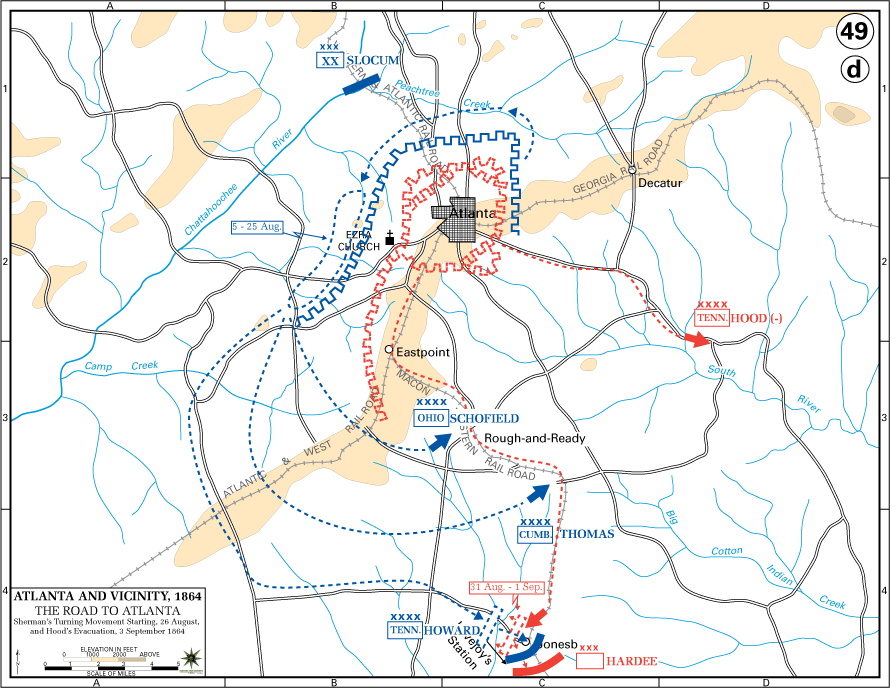Jonesborough, Georgia: The Battle that Doomed Atlanta
Like Corinth, Mississippi or Petersburg, Virginia, the town of Jonesboro, Georgia was significant to military planners and general officers for one simple fact: two or more railroads came to a junction there.
Running south from Atlanta was the Macon and Western Railroad and, 17 miles later, the railroad connected with the Atlanta and West Point Railroad.
By late August 1864, this railroad line was the life-line for Confederate Army of Tennessee, which was being besieged by William T. Sherman’s Union armies. Just like the Army of Tennessee at Petersburg, Virginia, the lifeline of the principle western Confederate army needed to remain intact.
Since the attacks of late July, John Bell Hood, the commander of the Confederate Army of Tennessee, had successfully defended any thrusts by Sherman. However, on the night of August 26, the Union army seemed to disappear from view. In fact, most of the Union soldiers did just that, swinging in a westerly movement to approach the Macon and Western Railroad below Atlanta.
The Confederate response would be a little slow in forthcoming.

After a conference with Hood, William Hardee, in charge of one of the three corps in the Army of Tennessee, was unofficially tapped to head an expeditionary force comprised of his and Stephen D. Lee’s corps to Jonesboro. From there, Hood’s orders were straightforward: Find the enemy, strike him, and remove the threat to the railroads.
The Confederate soldiers tramped south through the night of August 30th and arrived in their designated battle lines near Jonesboro between 9 a.m. and 10 a.m. However, that was just the vanguard of the approach; the rest of the units continued to file in as morning changed to afternoon.
Hardee, acting as the temporary head of the two-corps force, directed Major General Patrick Cleburne to lead Hardee’s Corps to begin the assault on the left of the Union line. When Cleburne became hotly engaged, Lee was to pitch into the opposite end of the Union lines.
Unfortunately, Lee was either new to the sound of heavy infantry fire in combat such as this or mistook unusually high skirmishing fire as the beginning of Cleburne’s assault.
Lee ordered his command forward, but the charge was doomed from the start—Cleburne had not started forward—and the Union line was free to concentrate on the South Carolinian’s veterans.
Even Lee admitted, “the attack was a feeble one.”
The Confederates, though, faced “volley after volley” that literally was “poured…into the faces of the gallant foe.”
Even some of the Yankee defenders admitted that the Confederates did not come on with their usual zeal, but instead marched into the guns with a resigned face, almost as if they were expecting death.

(courtesy of Military History online)
Lee admitted that some of his men went to ground before getting within 50 yards of the Yankee lines.
With Lee’s attack ebbing, Cleburne finally stepped forward, yet these piecemeal thrusts at a fortified Union line did nothing but add names to the casualty lists. The butcher’s bill for Lee’s Corps topped 1,300.
Add another 900 or so from Cleburne’s ranks and 2,200 veterans of Hood’s army fell in these attacks. Less than 200 casualties were counted on the Union side.
Jonesboro was lost, and with it went Atlanta—and with that, another nail was fixed in the coffin of the Southern Confederacy.
As noted on your map, the key thrust which led to the fall of Atlanta (i.e. Hood’s decision to abandon the city) was not so much the Battle of Jonesboro, but the taking of the Macon and Western Railroad on August 31 by the Army of the Ohio, led by Jacob Cox. They were tearing up the rails that day when a train from Atlanta saw them and reversed its path to bring the news to Hood that his supply line had been cut. As one of Cox’s men put it in a letter home a few days later, “What was their surprise and amazement when they found the Yanks had a death grip on their cornmeal.”